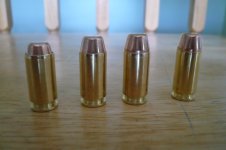That load on the left of the image is not from any standard box of ammo. It is a clear screw up. If you saw that in your handloads, you'd never give it a pass. Something went wrong with the seating tooling and nobody noticed in time to prevent it finding its way into a box. And in something moderately high pressure (as pistol loads go), like the 40 S&W, that kind of error can cause high pressure.
On another forum we had a member who had tested several hundred thousand rounds of ammunition as part of a government evaluation contract. He commented that if you shoot enough factory ammo, eventually you encounter every error that handloaders ever make: hot rounds, zero charge rounds, wrong seating depth, missing primer, backward primer, out of spec case. There are also errors a reloader never makes: a case with no flash hole (I've found two of these in bulk brass over time), a seated bullet jacket with no core, a backward seated bullet. Goofy stuff.
One time I discovered an LC Match 30-06 case I'd fired that felt funny. It was heavy toward the head. I looked inside with a flashlight and saw a suspiciously dark area down by the flash hole. My dental pick removed a 35 grain flattened piece of lead bullet core metal. The round probably ran a little high on pressure and velocity, but apparently not enough to be a serious issue, as I didn't recall any fliers during the match it was issued for. That was LC M72, and those loads ran mild anyway.
I generally inspect appearance and feel weight while loading magazines, regardless of the source of the ammo. I've wound up rejecting any number of .22 Rimfire cartridges that way over time. Mostly mangled or severely tipped bullets that probably would not have fed anyway.
If you have the time to spare, you can check rounds for weight and see if any outliers appear. I'd do that sorting ammo for a match or for a carry gun application. It's not enough rounds to make that extra effort impractical. But just for shooting at the range, nope. Sight and feel is all they get there.

